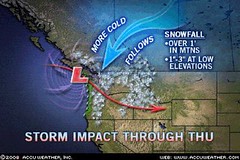 The Weather Alternative's long-range forecast for December 15-17 calling for warm temperatures and southerly air flows over the eastern Plains and Mississippi Valley was washed out by the recent frigid temperatures over the country's midsection.
The Weather Alternative's long-range forecast for December 15-17 calling for warm temperatures and southerly air flows over the eastern Plains and Mississippi Valley was washed out by the recent frigid temperatures over the country's midsection. On the 16th, there was somewhat of a warm up over the Gulf of Mexico but nothing of the magnitude I had expected over the eastern Plains and Mississippi Valley.
On the 16th, there was somewhat of a warm up over the Gulf of Mexico but nothing of the magnitude I had expected over the eastern Plains and Mississippi Valley.
From an astrological standpoint, this is usually due to the fact that one of the key charts is superseded by another. For example, sometimes an eclipse chart will become activated by an outer planet and overrides the Solar Ingress chart. I've been unable to research this specific example due to problems with my software program.
 The next Weather Alternative forecast for Dec 18-22, 2008 is shaping up, however. This forecast stated The Last Quarter Moon of Dec 19th opposes and squares this Solar Eclipse degree. This may trigger a storm system or front over western Canada and pushing into the Pacific Northwest.After the 21st temperatures should increase over the mid-Atlantic states leading to storms.
The next Weather Alternative forecast for Dec 18-22, 2008 is shaping up, however. This forecast stated The Last Quarter Moon of Dec 19th opposes and squares this Solar Eclipse degree. This may trigger a storm system or front over western Canada and pushing into the Pacific Northwest.After the 21st temperatures should increase over the mid-Atlantic states leading to storms.Accuweather reports that "Wednesday night (17th) and Thursday (18th), a storm will run along the arctic boundary, producing snow from Seattle to Pocatello, Idaho. Low elevations will get 1 to 3 inches of snow from this winter storm, while the high mountains can expect over a foot.
I'll continue to post the rest of the results as we get closer toward the 21st.
December 2008 Forecasts
Solar Eclipse Activation Fall 2008 Part 1
Introduction to the Weather Alternative
How Long-Range Forecasts Are Made
Christmas
It is not generally known that St. Francis of Assisi was responsible for that popular feature of the Christmas season--the manger scene. It came about because of his longing to make the great truths of the Spirit real to the ordinary person.
A candymaker in the state of Indiana in the USA wanted to make a candy that would represent God's Message to us, so he made the Christmas candy cane. In that simple shape, he incorporated several symbols for the birth, ministry, and death of Jesus Christ.
He began with a stick of pure white, hard candy--white to symbolize the virgin birth and the sinless nature of Jesus; and hard to symbolize the solid rock of faith and the firmness of the promises of God.
The candymaker made the candy in the form of a "J" to represent the precious Name of Jesus, Who came to Earth as our Savior. It could also represent the staff of the "Good Shepherd" with which He reaches down into the ditches of the world to lift out the fallen lambs.
Thinking that the candy looked somewhat plain, the candymaker stained it with four red stripes. He used three small stripes to show the stripes of the scourging Jesus received, by which we are healed. The single large red stripe was for the blood shed by Him on the cross so that we could have the promise of eternal life.
The candy became known as the candy cane--a familiar decoration seen at Christmas time, though few understand its intended symbolism. For us it can serve as a reminder of the wonder of Jesus coming down at Christmas and His great Love that remains the ultimate and dominant positive force in the universe today.
No comments:
Post a Comment